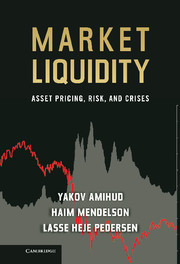Book contents
- Frontmatter
- Contents
- Acknowledgments
- Introduction and Overview of the Book
- Part I The Effect of Liquidity Costs on Securities Prices and Returns
- Chapter 1 Asset Pricing and the Bid–Ask Spread
- Chapter 2 Liquidity, Maturity, and the Yields on U.S. Treasury Securities
- Liquidity, Maturity, and the Yields on U.S. Treasury Securities*
- Chapter 3 Market Microstructure and Securities Values: Evidence from the Tel Aviv Stock Exchange
- Market Microstructure and Securities Values Evidence from the Tel Aviv Stock Exchange*
- Part II Liquidity Risk
- Part III Liquidity Crises
- References for Introductions and Summaries
- Index
Chapter 2 - Liquidity, Maturity, and the Yields on U.S. Treasury Securities
Summary and Implications
Published online by Cambridge University Press: 05 December 2012
- Frontmatter
- Contents
- Acknowledgments
- Introduction and Overview of the Book
- Part I The Effect of Liquidity Costs on Securities Prices and Returns
- Chapter 1 Asset Pricing and the Bid–Ask Spread
- Chapter 2 Liquidity, Maturity, and the Yields on U.S. Treasury Securities
- Liquidity, Maturity, and the Yields on U.S. Treasury Securities*
- Chapter 3 Market Microstructure and Securities Values: Evidence from the Tel Aviv Stock Exchange
- Market Microstructure and Securities Values Evidence from the Tel Aviv Stock Exchange*
- Part II Liquidity Risk
- Part III Liquidity Crises
- References for Introductions and Summaries
- Index
Summary
This article tests the Amihud–Mendelson (1986; Chapter 1 in this book) theory on the effect of liquidity on asset prices using data on U.S. Treasury securities, which, when held to maturity, are riskless. Therefore, the yield to maturity is the expected return over the remaining life of the bond. If two Treasury securities with the same maturity and cash flow have different yields, the difference must result from differences in their liquidity. This provides a controlled experiment on the effect of liquidity on asset expected returns without the need to control for risk.
Amihud and Mendelson study the return-liquidity relation by examining U.S. Treasury bills and notes with less than 6 months to maturity. U.S. Treasury bills are discount bonds, as are Treasury notes with less than 6 months to maturity (which have only one final payment). Thus, both securities have identical payoffs (a single payment at maturity), and if they have the same maturity, they should have the same price. However, the two instruments are traded in different markets with different trading costs, and this provides the basis for the test of a liquidity effect. Treasury notes are traded actively only during the period following their auction, in which they are purchased by primary dealers and turned around multiple times. During this active period of trading that follows the auction, they are called “on the run” securities. Thereafter, investors absorb the notes in their investment portfolios and, by the time the following auction takes place, trading volumes in the previously auctioned notes dwindle as the primary dealers, followed by other market participants, focus on the next auction, while the notes become “off the run” until their maturity. In contrast, Treasury bills, which are issued frequently and for short maturities, are actively traded until they mature. During the sample period of the study by Amihud and Mendelson, the brokerage fee per $1 million was $12.50–$25 for bills, compared to $78–1/8 for notes. The conventional bid–ask spreads per $100 face value for bills were around $1/128, compared to $1/32 for notes. In addition, the search and delay costs were significantly higher for notes than bills. Altogether, bills were much less costly to trade than notes.
- Type
- Chapter
- Information
- Market LiquidityAsset Pricing, Risk, and Crises, pp. 47 - 51Publisher: Cambridge University PressPrint publication year: 2012
- 2
- Cited by



